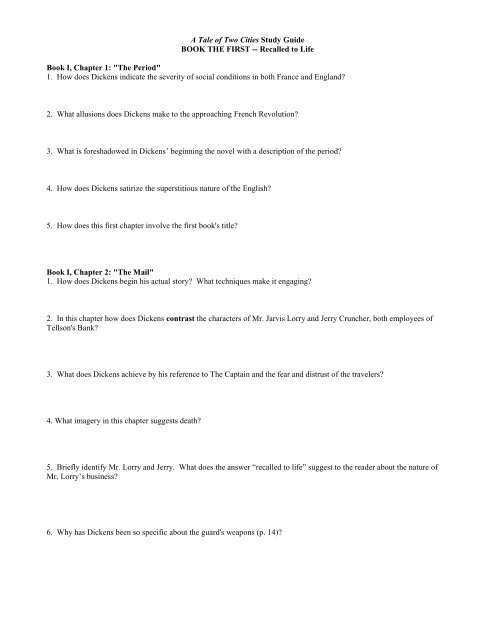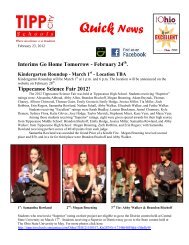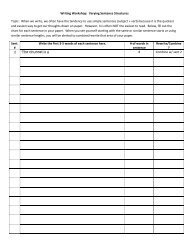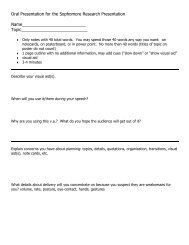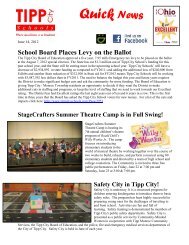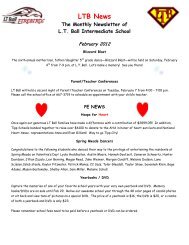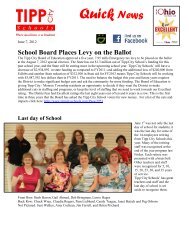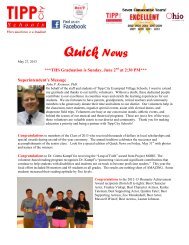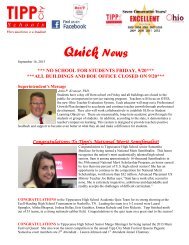A Tale of Two Cities Study Guide - Tipp City Exempted Village Schools
A Tale of Two Cities Study Guide - Tipp City Exempted Village Schools
A Tale of Two Cities Study Guide - Tipp City Exempted Village Schools
You also want an ePaper? Increase the reach of your titles
YUMPU automatically turns print PDFs into web optimized ePapers that Google loves.
A <strong>Tale</strong> <strong>of</strong> <strong>Two</strong> <strong>Cities</strong> <strong>Study</strong> <strong>Guide</strong><br />
BOOK THE FIRST -- Recalled to Life<br />
Book I, Chapter 1: "The Period"<br />
1. How does Dickens indicate the severity <strong>of</strong> social conditions in both France and England?<br />
2. What allusions does Dickens make to the approaching French Revolution?<br />
3. What is foreshadowed in Dickens’ beginning the novel with a description <strong>of</strong> the period?<br />
4. How does Dickens satirize the superstitious nature <strong>of</strong> the English?<br />
5. How does this first chapter involve the first book's title?<br />
Book I, Chapter 2: "The Mail"<br />
1. How does Dickens begin his actual story? What techniques make it engaging?<br />
2. In this chapter how does Dickens contrast the characters <strong>of</strong> Mr. Jarvis Lorry and Jerry Cruncher, both employees <strong>of</strong><br />
Tellson's Bank?<br />
3. What does Dickens achieve by his reference to The Captain and the fear and distrust <strong>of</strong> the travelers?<br />
4. What imagery in this chapter suggests death?<br />
5. Briefly identify Mr. Lorry and Jerry. What does the answer “recalled to life” suggest to the reader about the nature <strong>of</strong><br />
Mr. Lorry’s business?<br />
6. Why has Dickens been so specific about the guard's weapons (p. 14)?
Book I, Chapter 3: "The Night Shadows"<br />
1. What does Dickens achieve with is occasional lapses into first-person narration?<br />
2. Consider the message Mr. Lorry sends with Jerry Cruncher. What is revealed by the imaginary conversation Lorry<br />
keeps repeating in his mind?<br />
3. To what do the symbolism <strong>of</strong> the rising sun and Lorry's remark "Gracious Creator <strong>of</strong> day?" point thematically?<br />
4. What is the theme <strong>of</strong> the first two paragraphs <strong>of</strong> the chapter?<br />
Book I, Chapter 4: "The Preparation"<br />
1. What hints are there in this chapter that Mr. Lorry’s secret mission resurrects some issues from his own past?<br />
2. What are the blank forms for the consignment mentioned in this chapter? How do they contribute to Mr. Lorry’s need<br />
for secrecy and his use <strong>of</strong> the code “recalled to life”?<br />
3. How do Dickens’ characters conform to the literary conventions <strong>of</strong> his day?<br />
4. How is Dickens' 1859 infatuation with a young, blonde, blue-eyed actress named Ellen Ternan reflected in this chapter?<br />
5. How does this chapter elucidate Lorry's enigmatic message to Jerry?<br />
6. What detail in Dickens' portrait <strong>of</strong> the "wild-looking woman" is at once imposing yet humourous?<br />
7. What does the repetition <strong>of</strong> word “business” do to Mr. Lorry’s story and character?<br />
8. What is the significance <strong>of</strong> the quote: “The best and worst are known to you now.” (pg. 30)
Book I, Chapter 5: "The Wine-Shop"<br />
1. What do you think the spilled wine foreshadows in this chapter? Why did the wine-seller, Ernest Defarge, admonish<br />
Gaspard by placing his hand on the joker’s heart?<br />
2. What effect does Dickens achieve with personification in this chapter (and what is personified)? (p. 34-35)<br />
3. What does the following passage from this chapter say about the character <strong>of</strong> Madam Defarge?<br />
“...one might have predicted that she did not <strong>of</strong>ten make mistakes against herself in any <strong>of</strong><br />
the reckonings over which she presided.” (p. 36)<br />
4. What is implied in the way the Defarges call the men “Jacques”?<br />
5. How are the inhabitants <strong>of</strong> St. Antoine both literally and figuratively "gaunt scare crows"?<br />
6. What is the significance <strong>of</strong> Madame Defarge's knitting?<br />
Book I, Chapter 6: "The Shoemaker"<br />
1. The French King, Louis XVI, though honest and well-meaning, had neither the ability for nor an interest in politics and<br />
lost himself in an obsession for locksmithing, a hobby far below his social station. What is comparable in the wasted Dr.<br />
Manette? What makes the faintness <strong>of</strong> the shoemaker’s voice so horrible?<br />
2. What is significant about the shoemaker’s name?<br />
3. How do we know that nothing really misses the eyes and ears <strong>of</strong> Madame Defarge?<br />
4. What detail finally begins to bring the Shoemaker to his senses?<br />
5. How does Lucie begin to meet stereotypical expectations <strong>of</strong> an ideal woman?<br />
6. How is the conclusion <strong>of</strong> the first book both pathetic and comic?
1. Considering how the book was written in weekly installments, what techniques has Dickens used to maintain<br />
interest in his story each week?<br />
2. What use <strong>of</strong> exaggeration and caricature do you see in the character development thus far?<br />
3. How do the themes <strong>of</strong> resurrection, redemption, and secrecy play out in BOOK ONE?<br />
4. What symbols/recurring images & motifs have been introduced and what meaning do they hold at this point?<br />
5. In A <strong>Tale</strong> <strong>of</strong> <strong>Two</strong> <strong>Cities</strong>, Dickens uses vivid and <strong>of</strong>ten terrifying descriptive details to set a scene, create<br />
atmosphere, or portray a character. In Chapter 5, the descriptions <strong>of</strong> the misery in the Saint Antoine district <strong>of</strong> Paris<br />
around the wine shop and <strong>of</strong> the Defarges’s filthy staircase convey, in typical Dickensian style, the horror <strong>of</strong> those two<br />
places. Use the chart below to make a list <strong>of</strong> related descriptive words and phrases that help you visualize the scene.<br />
Saint Antoine<br />
The Defarges’ Staircase


